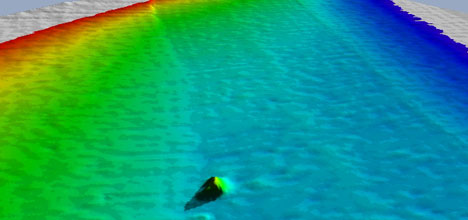A New Zealand designed and manufactured sonar is being used to locate containers lost from Rena, the container ship grounded on the Astrolabe Reef since October 5.
Auckland based Electronic Navigation Ltd has supplied one of its Wide Angle Seafloor Sonar Profiler (WASSP) multibeam sonars for use by hydrographic surveyors in the Rena Salvage effort.
Imagery of the seafloor generated by a WASSP multibeam sonar around the Astrolabe Reef.
Within 48 hours of the WASSP arriving in Tauranga, it identified 12 targets, seven of which were submerged containers – some at depths of up to 80m.
The surveyors involved in the salvage effort were surprised how quickly they were able to get the equipment fitted and the system up and running, says ENL general manager Ian McDonald.
Single beam echo sounders and side scan sonar has been used to support the salvage operation, however, MBES systems provide a more economic means of gathering seabed information, particularly in deeper waters.
With a WASSP 160kHz multibeam sonar, hydrographic surveyors are able to generate detailed seafloor profiles from 2-200m in depth and can accurately locate seafloor structure, shipwrecks and foreign objects in the water column.
'The WASSP Multibeam technology offers many advantages, mapping the seafloor with greater accuracy,” says Ian.
'For example, in 100 metres of water, the swath will cover a strip of sea floor 346 metres wide from port to starboard – 173 metres either side of the vessel.
'In relation to the Rena salvage, WASSP provides a means of covering a lot of seabed very quickly, which is crucial in a salvage operation.”

Sonar detects a container.
While multibeam and sidescan sonar technology is actively used by hydrographers and marine scientists to map and study the marine environment, the technology has until recently been bulky with large transducers requiring special hull mounts or needing to be towed, like side-scan sonar.
ENL addressed the shortcomings of traditional multi-beam sonar with WASSP, developing a cost-effective, easy to install, simple to use seafloor profiling system suitable for a wide range of applications in water up to 200 metres deep.
WASSP's Windows-based software is easy to use and will run automatically without requiring continuous operator input and all the functions are controlled by a computer mouse.
WASSP data can be exported to a third-party chart-plotting system and raw multi-beam sonar data can be saved for further analysis.
'WASSP is an extremely useful and cost-effective system, which captures critical information about the water column, seafloor and marine environment.
'It's the essential Multibeam Sonar for marine professionals,” says Ian.

A chart plotting sunken containers.
WASSP broadens the application of multi-beam sonar and side scan technologies with specially designed, innovative, high-performance sonar arrays that are compact enough to easily mount on vessels of all sizes.
WASSP WMB-160F is a real time 3D seafloor profiler, which is also able to display 2D bathymetric contour maps, function as a conventional echosounder, a side-scan sonar and as a triple-beam sonar with variable beam width. It can display up to four different views at once.



1 comment
FANCY TECH
Posted on 08-11-2011 18:20 | By SCARLET PIMPINEL
but still only found 33 of 88 containers? they must have drifted a long way ...
Leave a Comment
You must be logged in to make a comment.